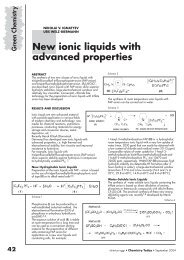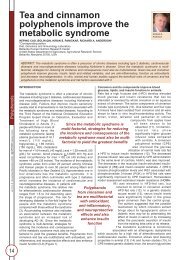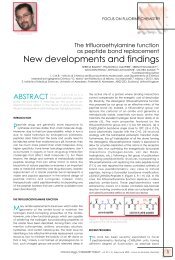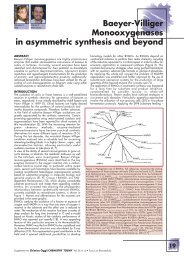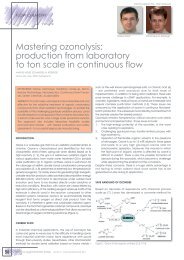tailor-made solutions for scalable processes - Chemistry Today
tailor-made solutions for scalable processes - Chemistry Today
tailor-made solutions for scalable processes - Chemistry Today
You also want an ePaper? Increase the reach of your titles
YUMPU automatically turns print PDFs into web optimized ePapers that Google loves.
ANDREAS MEUDT<br />
SVEN NERDINGER<br />
BERND LEHNEMANN<br />
Suzuki Coupling at Clariant:<br />
<strong>tailor</strong>-<strong>made</strong> <strong>solutions</strong> <strong>for</strong><br />
<strong>scalable</strong> <strong>processes</strong><br />
ABSTRACT<br />
Clariant, the first chemical company to develop an industrial-scale Suzuki process in the early 1990s, offers<br />
a broad portfolio of customized <strong>solutions</strong> <strong>for</strong> catalytic C-C coupling <strong>processes</strong> from gram to ton scale. This<br />
article highlights latest industrial developments in this area, with a special emphasis on the production of the<br />
required boronic acids. Latest development in this area is a new synthesis method <strong>for</strong> aliphatic boronic<br />
acids, using a newly developed hydroboration-based method. Furthermore, alternative syntheses of biaryls<br />
are discussed which sometimes are more economic than Suzuki couplings.<br />
The Suzuki coupling reaction - the transition-metal catalyzed C-C bond <strong>for</strong>mation between an<br />
organoboronic derivative and an organohalide or sulfonate - is a valuable tool <strong>for</strong> the organic chemist.<br />
It is - although still constantly being improved 1 - widely employed <strong>for</strong> construction of biaryl and heterobiaryl<br />
structures in the laboratory and - within the last ten years - has found its way into industrial manufacture of<br />
fine and specialty chemicals, too.<br />
HISTORY: THE OTBN STORY<br />
When in the early 1990s the sartanes family of angiotensin converting enzyme inhibitors emerged from the<br />
initially introduced Losartan 2 , O-tolylbenzonitrile (OTBN) was chosen as a starting material <strong>for</strong> the industrial<br />
production of one of these compounds (Scheme 1). The first syntheses being lenghty and expensive (5 steps),<br />
about ten companies tried to find a more economic production route to this biphenyl structure, among them<br />
the part of <strong>for</strong>mer Hoechst AG which is now part of Clariant’s Pharmaceutical Fine Chemical Business.<br />
They decided to investigate a C-C coupling pathway, leading to one of the first industrial-scale applications<br />
of a Suzuki protocol ten years ago.<br />
To fit the needs of a large-scale Suzuki process, it was necessary to find a catalyst system which could be<br />
easily recycled and would provide the product in high yields with high selectivity at low palladium loadings.<br />
Furthermore, the reaction conditions had to allow easy separation of the product from the reaction mixture.<br />
Clariant’s approach (shown in Scheme 1) was based on the water-soluble ligand tris(3-sulfonatophenyl)<br />
phosphine (TPPTS) which is commercially<br />
available and - when used in a biphasic<br />
reaction medium - allows <strong>for</strong> easy reuse of<br />
the aqueous phase carrying the catalyst<br />
while the product is isolated from the<br />
organic phase 3 . Several hundred tons of<br />
OTBN have been produced using this<br />
process.<br />
Scheme 1: The sartanes, their precursor OTBN and Clariant’s Suzuki approach<br />
6<br />
COUPLING OF<br />
NON-ACTIVATED AND<br />
DEACTIVATED SUBSTRATES<br />
In the meantime, Suzuki coupling has<br />
emerged as the most common tool <strong>for</strong><br />
C-C coupling in the fine chemicals area<br />
due the usually mild reaction conditions,<br />
good yields and high functional group<br />
tolerance. Although the palladium-TPPTS<br />
system is still successfully applied to many<br />
Suzuki couplings and often shows far<br />
superior reactivity compared to other<br />
early-generation catalyst systems like<br />
CHIRAL CATALYSIS - Oxidation and C-C Coupling supplement to chimica oggi • <strong>Chemistry</strong> <strong>Today</strong>
tetrakis(triphenylphosphine)palladium,<br />
especially with aryl and heteroaryl<br />
bromides, new synthetic and economic<br />
challenges involving heteroaromatic<br />
coupling partners and cheap but less<br />
reactive non-activated chloroaromatics<br />
lead to the discovery of new, highly active<br />
catalyst systems. Due to the excellent<br />
backwards integration with Clariant’s<br />
know-how in boronic acid production und<br />
aromatic halogenation, Clariant offers<br />
<strong>tailor</strong>-<strong>made</strong> <strong>solutions</strong> <strong>for</strong> all the<br />
pharmaceutical industry’s needs <strong>for</strong><br />
coupling products. For example, a highly<br />
versatile catalyst system developed by Fu<br />
and co-workers, palladium/tri-tert-butyl<br />
phosphine (Scheme 2), shows excellent<br />
results in the coupling of deactivated aryl<br />
chlorides at low catalyst loads4 and is not<br />
patent protected, thus being a system of<br />
choice <strong>for</strong> the outsourcing needs of pharmaceutical companies who do not want to depend on a single<br />
source or complicated intellectual property situations. In many cases even tricyclohexylphosphine is a<br />
sufficiently active ligand - not only <strong>for</strong> palladium, but also <strong>for</strong> nickel which can often be used as a substitute.<br />
With Clariant’s experience in organometallic chemistry, we are able to make customized phosphine ligands<br />
as well. For instance, the reaction of 2-hydroxybiphenyl with phosphorus trichloride and then with a<br />
Grignard compound leads to high yields of 2-dialkylphosphino-2’-hydroxybiphenyls5 Scheme 2: Suzuki coupling of deactivated aryl chlorides using Fu’s catalyst systems<br />
which show very high<br />
activities in challenging couplings.<br />
SUZUKI COUPLING OF HETEROAROMATIC SUBSTRATES<br />
Heteroarylphenyl and biheteroaryl derivatives are becoming more and more important as pharmaceutical<br />
building blocks, especially those involving pyridine- and furane-derived structures. Both heteroarylboronic<br />
acids and heteroaryl halides can be used to assemble these structures. With six-membered nitrogen<br />
heterocycles palladium on charcoal has<br />
been shown to be an efficient and costeffective<br />
catalyst<br />
(Scheme 3a). Although the literature states<br />
that addition of a phosphine ligand is<br />
essential <strong>for</strong> these couplings 6 , we have<br />
found a way to conduct the reaction under<br />
ligand-free conditions in high yields.<br />
This allows <strong>for</strong> easy isolation and<br />
purification of the product.<br />
Most heteroarylboronic acids and halides<br />
can be coupled under Suzuki conditions,<br />
including those derived from electron-rich<br />
heterocycles, i.e. furans and thiophenes<br />
(Scheme 3b).<br />
Additionally, Clariant has developed a<br />
copper-mediated method <strong>for</strong> the assembly<br />
of 4-arylpyridines from arylgrignard<br />
reagents and pyridines (Scheme 3c).<br />
1,4-Addition of the Grignard reagent leads<br />
to a 1,4-dihydropyridine which is easily<br />
reoxidized to the pyridine. The main<br />
advantage of this method is that normal<br />
pyridines can be used which are usually<br />
ten to fifty times cheaper than the<br />
corresponding halopyridines.<br />
C-C-COUPLING<br />
Scheme 3: Heteroaryl couplings using a) heteroaryl halides,<br />
b) heteroaryl boronic acids and c) halide-free pyridines<br />
ALIPHATIC COUPLINGS<br />
So far most alkyl boronic acids could not be coupled with satisfying yields under standard Suzuki conditions<br />
because of predominant beta-hydrogen elimination which seriously constrains the utility of the Suzuki<br />
reaction. Clariant is currently developing a process <strong>for</strong> Suzuki coupling of vinylic and especially alkyl<br />
boronic compounds 7 . Together with the new hydroboration-based pathway to functionalized alkyl and<br />
CHIRAL CATALYSIS - Oxidation and C-C Coupling supplement to chimica oggi • <strong>Chemistry</strong> <strong>Today</strong><br />
7
8<br />
C-C-COUPLING<br />
alkenylboronic acids described below, this new method provides a convenient way to assemble structures<br />
that haven’t been accessible by the Suzuki method be<strong>for</strong>e.<br />
INDUSTRIAL MANUFACTURE OF BORONIC ACIDS<br />
Most boronic acids are produced by reacting an organometallic species - usually an organolithium or a<br />
Grignard compound - with a trialkylborate, followed by aqueous workup. The organometallic species is<br />
usually <strong>for</strong>med by Grignard reaction or halogen-metal exchange using an aryl halide as starting material.<br />
But many aryl chlorides fail to undergo the Grignard reaction, and in general chlorides are not suitable <strong>for</strong><br />
halogen-metal exchange so that the<br />
expensive bromides have to be used. For<br />
this purpose Clariant has developed its<br />
lithium technology - the chloroarene<br />
precursor is metalated using solid lithium<br />
metal, and the resulting organolithium<br />
species is then reacted with a trialkyl<br />
borate (Scheme 4a). Apart from obviating<br />
the need to use expensive bromo<br />
compounds <strong>for</strong> direct metalations of<br />
haloarenes, this new methodology<br />
additionally gives rise to <strong>tailor</strong>-<strong>made</strong><br />
organolithium bases that are <strong>made</strong> in situ<br />
from chlorinated precursors and can be<br />
used <strong>for</strong> metalation of C-H acidic<br />
substrates like furanes or indoles<br />
(Scheme 4b).<br />
Aliphatic boronic acids are not as readily<br />
available as aromatic and heteroaromatic<br />
ones. Recently a broadly applicable<br />
method <strong>for</strong> the production of<br />
functionalized alkyl and alkenyl boronic<br />
acids has been devoloped by Prof. Victor<br />
Snieckus’ group in collaboration with<br />
Clariant 8 .<br />
When 2,5-dimethylhexa-2,4-diene is<br />
reacted with borane or a borane source,<br />
diisopropylprenylborane (iPP 2 BH) is<br />
<strong>for</strong>med almost exclusively. This reagent<br />
which can be generated and used in situ<br />
combines properties of both<br />
disiamylborane and allyl boranes. It can<br />
be used to hydroborate alkenes and<br />
alkynes, and the hydroboration products can be trans<strong>for</strong>med into boronic acids and esters under mild<br />
conditions (Scheme 4c). Finally these boronic ester can be either isolated or used directly <strong>for</strong> Suzuki<br />
coupling reactions.<br />
Another method currently evolving from the university laboratories is the Pd-catalyzed coupling of<br />
haloarenes with bis(pinacolato)diboron to yield boronic pinacolate esters. Using this method<br />
hydrolysis-sensitive boronic compounds can be prepared.<br />
In some cases even C-H-functionalization is possible using Rh or Ir catalysts. The main drawback of this<br />
reaction is the high price of the boron reagent and the bad atom economy of the reaction (one equivalent of<br />
boron is discarded) which precludes its use <strong>for</strong> large-scale <strong>processes</strong> (Scheme 4d).<br />
Scheme 4: Manufacture of boronic acids using Clariant’s lithium technology<br />
(a) direct metalation, b) proton abstraction by an in situ <strong>made</strong> custom base),<br />
c) diisopropylprenylborane and d) bis(pinacolato)diboron<br />
OTHER ISSUES<br />
For pharmaceutical use it is very important to achieve very low residual palladium contents in the final<br />
product. Usually these strict specifications can not be met by standard workup procedures. Even with<br />
heterogenous catalysts the amount of heavy metals leaching from the substrate is too high to be acceptable<br />
<strong>for</strong> pharmaceutical building blocks, especially in later stages of the synthesis. Apart from standard<br />
procedures like distillation, adsorption and complexation which are routinely employed to lower palladium<br />
contents 9 Clariant has developed their own proprietary technology to reach residual heavy metal contents<br />
as low as 1-2 ppm, employing readily available and cheap materials.<br />
It is often an option to use nickel instead of palladium since most of the residual nickel can be easily<br />
separated during work-up simply by proper pH adjustment, too. Besides this advantage, nickel is also<br />
traded about 50-fold cheaper than palladium and not subject to daily price changes. For activated aryl<br />
halides Pd can often be substituted by Ni. Even tosylates are amenable to nickel-catalyzed Suzuki coupling,<br />
and when no sensitive functional groups are present, Kumada coupling employing Grignard reagents<br />
CHIRAL CATALYSIS - Oxidation and C-C Coupling supplement to chimica oggi • <strong>Chemistry</strong> <strong>Today</strong>
C-C-COUPLING<br />
instead of boronic acids can be used where Ni catalysts often show superior selectivity in terms of less<br />
homocoupling-derived byproducts. At Clariant, Kumada couplings using either Pd or Ni catalysts have been<br />
per<strong>for</strong>med on a several hundred kilogram scale, too.<br />
Another important issue when it comes to industrial-scale <strong>processes</strong> are intellectual property rights.<br />
For kilo-lab and piloting campaigns <strong>for</strong> early-stage pharmaceutical intermediates whose clinical success<br />
probabality is naturally limited it is often too circumstantial to negotiate about licencing issues, and<br />
pharmaceutical companies often do not want to rely on a single source. For this reason, Clariant tries to use<br />
proprietary technologies and methods or catalysts which are available without the necessity of preliminary<br />
intellectual property agreements whenever possible to achieve a maximum of flexibility and independence<br />
from third parties <strong>for</strong> the customer.<br />
Clariant has gained experience in cross-couplings from pilot plant up to several hundred ton scale <strong>for</strong> more<br />
than ten years now, having manufactured more than 25 different carbocyclic and heterocyclic boronic acids<br />
and more than 20 different biaryls, heterobiaryls and oligophenyls on an industrial scale. Backed up by this<br />
know-how, Clariant is well prepared <strong>for</strong> future challenges: The trend towards ever increasing substrate<br />
complexity as well as heteroatom and functional group diversity at increasing economic efficiency is clearly<br />
visible.<br />
ANDREAS MEUDT*, SVEN NERDINGER<br />
BERND LEHNEMANN<br />
* Corresponding author:<br />
Clariant GmbH<br />
Industriepark Höchst, Building D569<br />
D-65926 Frankfurt - Germany<br />
REFERENCES<br />
1. <strong>for</strong> recent reviews see F. Bellina, A. Carpita, R. Rossi, Synthesis 2004,<br />
15, 2419, and references cited therein.<br />
2. R.D. Larsen, A.O. King, C.Y. Chen, E.G. Corley, B.S. Foster, F.E. Roberts,<br />
C. Yang, D.R. Lieberman, R.A. Reamer, D.M. Tschaen, T.R. Verhoeven,<br />
P.J. Reider, Y.S. Lo, L.T. Rossano, A.S. Brookes, D. Meloni, J.R. Moore,<br />
J.F. Arnett, J. Org. Chem. 1994, 59, 6391.<br />
3. S. Haber, J. Manero, EP 0694530 (Hoechst AG), 1995.<br />
4. A.F. Littke, C. Dai, G.C. Fu, J. Am. Chem. Soc. 2000, 122, 4020.<br />
5. H.-J. Kleiner, D. Regnat, EP 0748811 (Hoechst AG), 1996.<br />
6. T. Tagata, M. Nishida, J. Org. Chem. 2003, 68, 9412.<br />
7. To be published soon.<br />
8. A.V. Kalinin, S. Scherer, V. Snieckus, Angew. Chem. Int. Ed. 2003, 42,<br />
3399.<br />
9. C.E.Garrett, K. Prasad, Adv. Synth. Catal. 2004, 346, 889.<br />
CHIRAL CATALYSIS - Oxidation and C-C Coupling supplement to chimica oggi • <strong>Chemistry</strong> <strong>Today</strong>



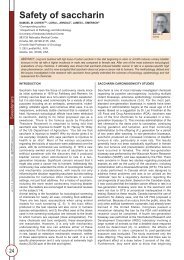
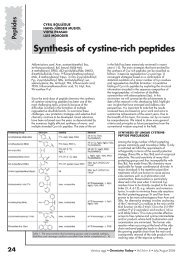
![Pietro Delogu [modalità compatibilità]](https://img.yumpu.com/12255149/1/190x135/pietro-delogu-modalita-compatibilita.jpg?quality=85)
